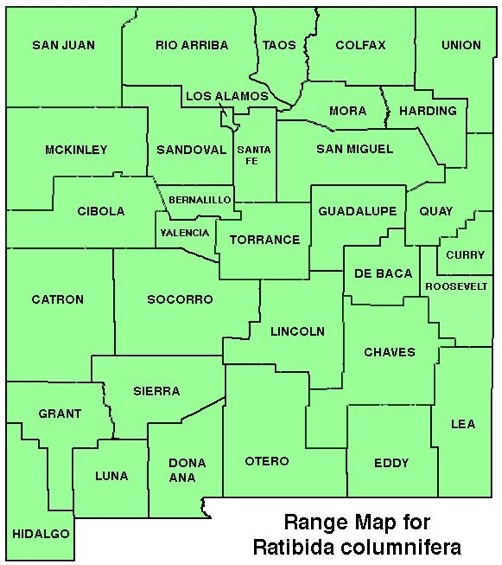WILDFLOWERS OF NEW MEXICO

The colorful flower heads of this plant shout for attention. Perched on the top of 1–4-foot tall, leafless, hairy stems, the flowers may be solid yellow, maroon, or a blend. The plant forms dense, rounded clumps with as many as 15 or more stems. Note the drooping rays surrounding the long cylinder of tiny disk flowers.
FLOWER: April–July. 4–12 petal-like ray flowers, reach 1-inch long (25 mm) with slightly notched tips. The rays droop around a 1/2–2-inch tall (12–50 mm) column of brown disk flowers.
LEAVES: Basal leaves often wither by flowering. Alternate stem leaves mostly on the bottom portion of the plant. Blade compound, 2–4-inches long (5–10 cm), roughly hairy; cut into long, narrow opposite lobes (pinnate) along midrib.
HABITAT: Dry to moist, sandy, gravelly, loamy, limestone soils of prairies, meadows, roadsides, disturbed areas; pinyon-juniper, pine forests.
ELEVATION: 4,000–9,000 feet.
RANGE: Widespread west of the Mississippi River.
SIMILAR SPECIES: Short-ray Prairie Coneflower, R. tagetes, statewide, has short rays and flower heads barely above the leaves. Blackeyed Susan, Rudbeckia hirta, has yellow ray flowers and a dome-shaped (not cylindrical) central disk.
NM COUNTIES: Statewide at numerous low- to mid-elevation habitats.









PRAIRIE CONEFLOWER, MEXICAN HAT (red & yellow)
RATIBIDA COLUMNIFERA (Ratibida columnaris)
Aster Family, Asteraceae
Perennial herb









THE CONTENTS OF THIS WEBSITE ARE COPYRIGHTED AND CANNOT BE USED
WITHOUT PERMISSION OF GEORGE OXFORD MILLER





















































Leaf blade cut into long, narrow opposite lobes (pinnate) along midrib (arrow).


















EMAIL ME







